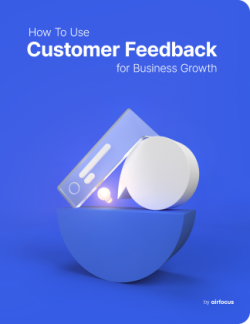Product feedback is any information that you receive about your product. This includes suggestions on improvements, thoughts, and general sentiments.
Feedback comes in various forms, from many channels, and from different stakeholders.
Some of the stakeholders that feedback can come from includes: customers, users, industry analysts, sales, marketing, customer success, and customer support.
While all of these stakeholders are important, the most important type of feedback that you will receive on your product will come from customers.
This is because paying, happy customers not only help companies remain profitable, but when they are treated well they help companies grow and thrive.
Customers are those that pay for a product while users are the ones who are regularly engaged with a product to accomplish their goals.
Whose feedback is more important, the customer or the user?
The user’s feedback is more important, however, and pay attention to this, product teams should not focus solely on them. While gathering user feedback is important, it’s also essential to gather customer feedback to ensure that their goals are also being met. Especially when the customer and user are different stakeholders.

Why is customer feedback so vital for businesses and product teams?
Customer feedback is vital for multiple reasons. These include that:
Customer feedback informs you how your customers feel about your product
Customer feedback helps makes prioritization easier
Customer feedback leads to new uncovered problems to tackle
Which customers should feedback be collected from?
While some product teams may choose to focus on a specific subset of their customers you should actually make it an effort to collect feedback from as many of your customers as possible.
The frequency and period between these feedback sessions is up to you. I recognize that you may already have a busy schedule however this is one item that needs to be on your schedule.
Collect feedback from your most engaged customers.
These customers are the most invested in your product and likely know your product in and out. Collect feedback from them to understand what keeps them engaged and ensure that they stay engaged.
Their feedback may assist you in obtaining more engaged customers.
Collect feedback from your least engaged customers
Before you collect feedback from your least engaged customers you need to know who they are. This is why using a customer engagement tool that will give you a pulse on your customers is beneficial.
Elicit feedback from these customers to understand why they are not engaged. There could be a plethora of reasons which you may not uncover until you reach out to them to understand why. Was it a recent price hike? Frequent bugs? Or is the product too difficult to use?
Low engagement leads to customer churn, and no one wants high churn rates.
It costs five times more to acquire a new customer than sell to an existing one. So speak to these customers to understand what changes you need to make to turn them from low engaged to highly engaged customers.

Collect feedback from internal stakeholders
Seek feedback from your internal team as well. They also engage with products on a regular basis and may have great ideas to improve the product.
Improvements for not only the customer base, but even the business as well (improve the experience for team members as they interact with the product).
How does the product lifecycle impact customer feedback?
The product lifecycle is the journey that all products go through from birth (when it is first introduced to the market) to retirement (once the product has been sunsetted).
Seeking and gathering customer feedback should never stop. This should remain an ongoing activity, despite what stage of the lifecycle your product is in.
However, the type of feedback and the timing may change based on the stage.
Each stage of the product lifecycle presents various opportunities, risks, and challenges for product teams.
As you introduce a new product to the market and manage it through it’s potential decline, maintain a very close relationship with customers and stakeholders and elicit their feedback throughout their journey with the product.
This will help you ensure that you are gathering the information that your team needs to understand customer and stakeholder sentiments, uncover problems, prioritize them, and ultimately ensure that key stakeholders are receiving value from your products.
What are the various types of feedback?
Feedback can fall into two main categories: feedback you receive without asking and feedback you actively seek.
Some of the mediums of feedback that you can receive from customers include:
App reviews
Usability tests
App/website metrics
Industry analysts

Managing feedback requests
Here are a few key things to keep in mind when it comes to feedback requests:
See how many customers have made similar requests (this can help determine priority)
Strive to understand the “why” of requests
Do not give your customers exactly what they ask for
Document your customer feedback in a central repository
Actioning customer feedback
After receiving customer feedback your team should record this information with the important details and then spend further time digging deeper on why your customers are making their requests (consider the five whys exercise).
Also, perform research to ensure that the feedback will benefit your customer base as a whole, products are not built to solely please one customer.
This research includes understanding how many other customers have provided similar feedback, are their reasons similar, and what value can taking advantage of the opportunity bring, as well as the effort.
This is important to help you decide whether to implement the feedback or not.
Setting up your feedback loop
Customers don’t always expect that their feedback will be actioned upon.
However, if feedback continues to be provided and customers notice that it is either not actioned upon or there are no updates whatsoever then this can sour the relationship.
While you don’t have to act on every piece of feedback provided by customers, you should inform them, and your internal team, what the next steps are for the feedback provided to date.
Ensure that you have a process in place for how you will act on customer feedback (or not).
As feedback is received, who is responsible for reviewing it, at what frequency will it be reviewed, what are the different statuses that feedback can have, and once reviewed, what happens next? These are the questions that should be considered in your feedback loop.
And whether you decide to act on customer feedback or not, when will you let customers know and how?
Customers of SaaS products understand that they are not dealing with a development agency; they don’t expect to receive everything they ask for.
While they certainly appreciate when their requests are considered and factored into the product, they also appreciate staying informed on the feedback that they provided.

Quadri Oshibotu

Read also
All product feedback in one place






